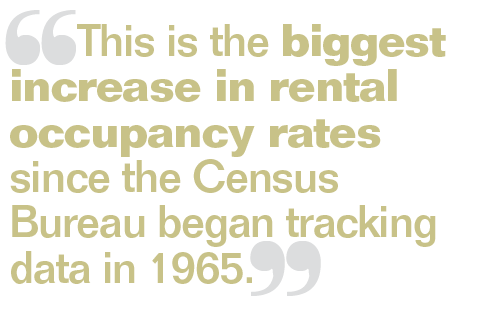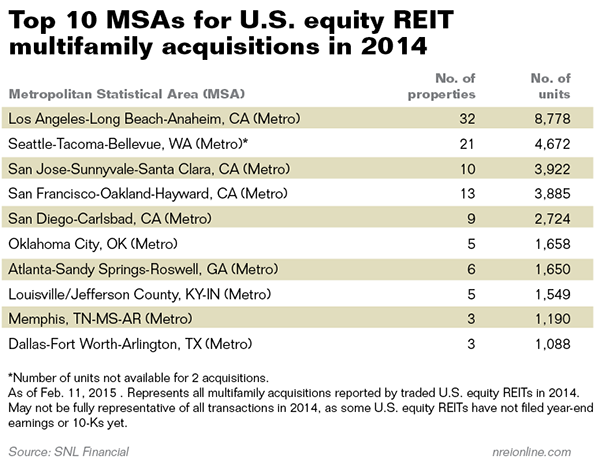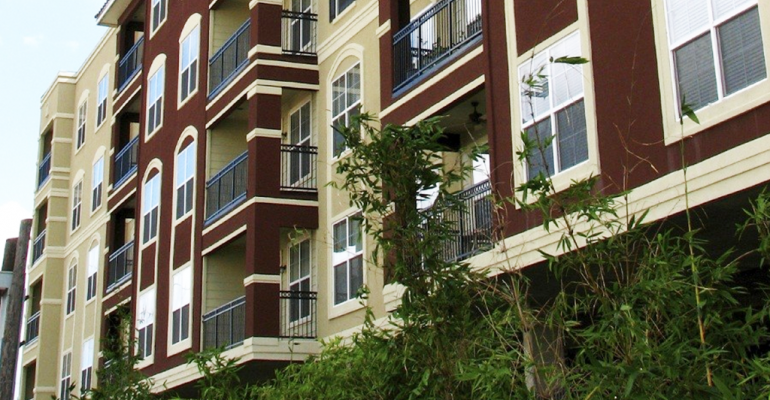More renters meant more profits for multifamily REITs in 2014, which provided tremendous returns to their investors over the last year.
“This is clearly a solid time for the whole multifamily REIT sector,” says Calvin Schnure, an economist and senior vice president of research and economic analysis for the National Association of Real Estate Investment Trusts (NAREIT).
The outlook for REITs is also good, with demand expected to stay strong for the foreseeable future, according to NAREIT, improving demand from investors.
REITs had a great start to the new year
Apartment REITs delivered a 6.96 percent return to investors in January, including a 2.88 percent return from dividends, according to NAREIT. That’s a very high return for just one month—for many real estate investments, about 7 percent would be an acceptable return for an entire year. In comparison, the S&P 500 fell 3.0 percent in January.
Investors in apartment REITs may be getting used to very strong returns after receiving a 39.62 percent total return in 2014, including a dividend yield of 2.88 percent. That’s compared to a 14.22 percent for the S&P 500. Apartment REITs also did better than all-equity REITs overall in 2014, which earned a total return of just 28.03 percent.
 Strong stock prices reflect strong performance from the REITs. “We’ve seen good, solid growth in earnings,” says Schnure.
Strong stock prices reflect strong performance from the REITs. “We’ve seen good, solid growth in earnings,” says Schnure.
Demand is high for apartments, and Schnure expects REITs to benefit from demand for apartments that is stronger than supply of apartments for the foreseeable future. The number of rental households surged by a record 2 million units over the past four quarters as the acceleration in job growth begins to unlock pent-up demand for rental housing. “This is the biggest increase in rental occupancy rates since the Census Bureau began tracking data in 1965,” says Schnure.
Schnure estimates there are 3 million or more “shadow households” in the form of people doubled-up with roommates or family members. These individuals are likely to search for their own apartment as they get first jobs, better jobs or raises. REITs are in a strong position to capture these new renters. “They tend to own investment properties in gateway cities— that’s where the demand is,” says Schnure.
Developers are building new units, but not enough to hurt REITs. “I am not at all worried about new supply,” says Schnure. “This growth in rental demand is likely to outpace the new supply of apartments in the pipeline, supporting the outlook for multifamily housing stocks.” Developers are now building new apartments at a rate of 300,000 to 350,000 a year. “That is not keeping up with demand,” Schnure notes.
Affordability is the biggest thing holding back apartment REITs—and the broader apartment market. “The number of renters paying 30 percent or more of their income on rent is high,” says Schnure. “That is putting a cap on rent growth, which puts a cap on earnings growth for apartment REITs.”
Nationwide, rents continued to grow in the fourth quarter, but at a slower pace than in prior years. “With the job market picking up, normally rent growth would be several percentage points high than it is right now,” says Schnure.
REITs turn to secondary markets
REITs continue to deploy their available capital to buy up properties and grow their portfolios, experts say. However, as economic recovery spreads, REITs have become more interested in secondary markets.
“There seems to have been a shift back into secondary markets after being very focused on major markets during 2013,” says Ben Carlos Thypin, director of market analysis for Real Capital Analytics. REITs made 35.91 percent of their purchases in secondary markets in 2014, up from 24.05 percent in 2013. With the exception of 2012, that’s the biggest concentration on secondary markets that the REITs have shown since 2009. Before the crash, REITs regularly made well over a third of their purchases in secondary markets.
“It makes sense,” says Schnure. “Capitalization rates are low in secondary markets. We have also seen recovery spreading to secondary markets in 2014 from gateway cities.”


